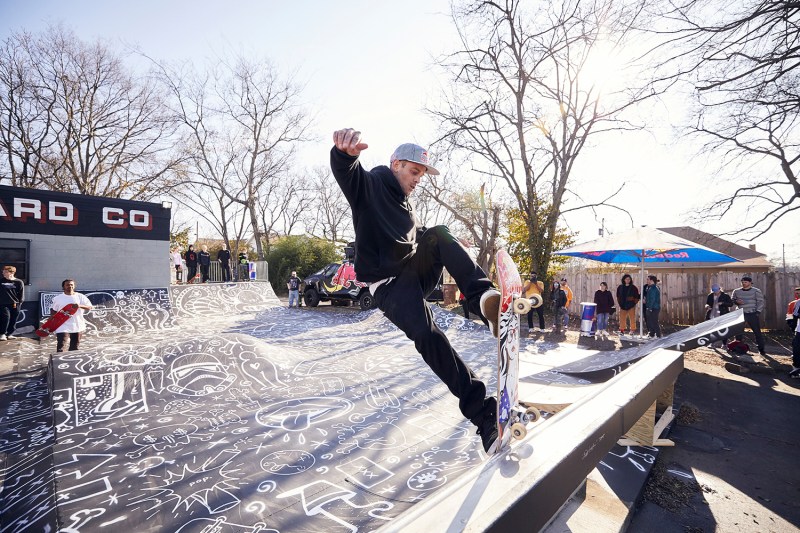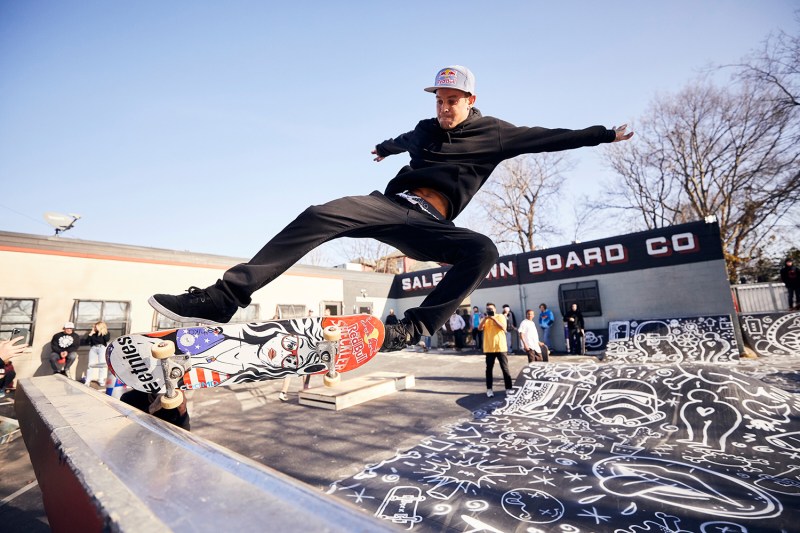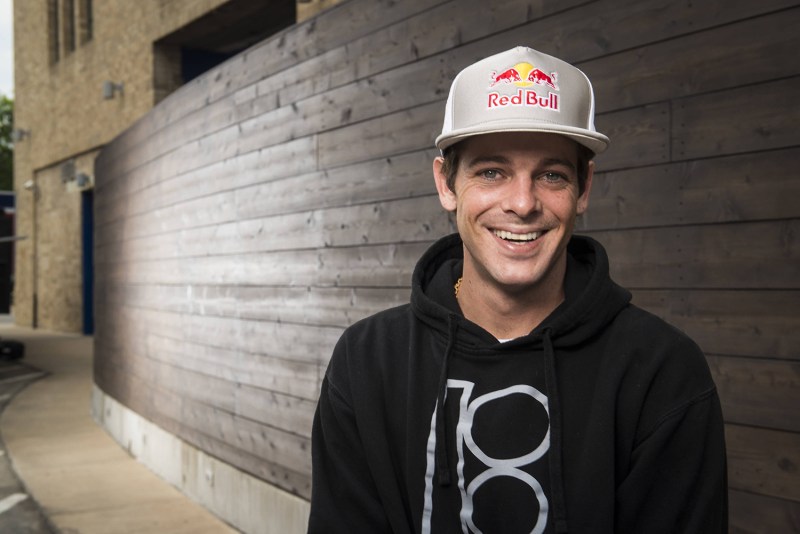
“I knew it had the potential, with the type of contests that was going on,” says Ryan Sheckler. And he should know: Shecks, as he’s called by action sports broadcasters around the world, has not a little amount of experience in the field, competing in skateboarding contests since the age of six. That means that he’s been doing it since 1995, the same year the X Games threw its inaugural contest on ESPN. Next came the Dew Tour, in 2008, and then Street League Skateboarding, the brainchild of pro skater and reality TV star Rob Dyrdek, in 2010. With these series drawing millions of viewers, there was no shortage of mainstream exposure. But the final step was always the Olympics, and this summer, in Tokyo, the sport of skateboarding will finally make its Games debut, just as Sheckler predicted.
“Skateboarding has that cool factor,” Sheckler, now 31, tells The Manual. “I think that the Olympics realize that there are millions of kids skateboarding, and it is a sport. I knew it was just a matter of time.”
Even if you grew up kickflipping in parking lots, the Olympics’ version of skateboarding, which will be decided over four days between July 25 and August 5, may be tough to understand. The differences between a run, or a series of tricks executed over a period of time, and its best trick section are easy to pick up. Street versus park? The same. But how each is scored, how that score is totaled, and how an eventual medal winner is determined can get a little muddy, as is the strategy to get there. So we sat in on a Red Bull panel with Sheckler, who broke down the Olympic skateboarding format and structure for the everyman. Whether you’re an OG skater boi or someone who just loves the Olympics, one of the sport’s best will explain its biggest contest to date.
The Disciplines

There are two skateboarding disciplines at the Olympics: Park and street.
Park is essentially the modern version of the halfpipe, and it’s contested by the modern version of that discipline’s athletes. Rather than the halfpipe’s swing set-like repetition, park courses bend its curved surfaces, called transitions, over a greater footprint, breaking and arranging them at acute and obtuse angles instead of the mirror image. This creates a swimming pool-like depression, and ol’ Hef’s Playboy Mansion grotto didn’t have more tucked-away corners in which to play. It’s within this area that skateboarders grind or slide along the pool’s edges, called coping, and use its sides to build speed and blast big airs.
The street discipline, in contrast, is much more linear focused. Its “plaza” style of construction, like you might find in most major cities, was envisioned by Dyrdek in the Aughts and has come to dominate modern skatepark design. Its notable features include ledges, rails, gaps, and stair sets in a roughly rectangular area. Transitions, if they appear, are few and rare, and while speed sometimes plays a part, its features are generally about technicality and board manipulation rather than the size of an air.
Twenty men and twenty women will compete in each discipline, for a total of 80 athletes.
The Training
Long gone are the days when skateboarders would stay out late, ingesting anything under the sun. (Well, those days may not be totally gone, but you won’t see those athletes at the Olympics.) Now, pro contest skaters have literal staffs, from strength coaches to massage therapists, dietitians, sports psychologists, and more. We admit it may be less punk to get a good night’s sleep, but there’s also a hell of a lot more money at stake. Guys like Nyjah Huston and Sheckler have been training for more than a decade. “Thats the thing that people don’t know,” Sheckler says, crediting the regimen for helping him stay healthy despite such a brutal sport. “I can say that if I never trained, I don’t know if I’d be [here] right now.”
The same goes for the tricks themselves: “We know that we’ve put in the time,” he says. “We’ve learned the tricks, we’ve dedicated the hours to our body, and we know what to do. It’s all about being able to channel the emotions, the energy, the focus. That’s what it really breaks down to on competition day.”
The Scoring

Scoring in park is relatively straightforward: Three 45-second “runs,” or blocks of time, during which skaters string together their best tricks. At the end of each run, a score is awarded based on the judges’ perception of the composite tricks’ difficulty. A skater’s best score ranks him in the heat standing, and from the four prelim heats of five skaters each, eight skaters with the highest individual scores advance to a final. In the final, the process resets, and after three runs each, the top three skaters by singular score are awarded the gold, silver, and bronze. It’s simple.
Street, on the other hand, is much more convoluted. Start with two 45-second runs for each skater, which are scored in a manner similar to park. However, both scores will initially be counted and totaled. Then the contest moves to a “Best Trick” section, which allows skaters to pick whatever obstacle they prefer to exhibit their best one-off moves on. Each athlete has five best-trick turns and is allowed to repeat attempts if they fail to complete a trick. They may also elect to move to another obstacle at will. Best Trick scores are judged and recorded on the same scale as the run section — at least until a skater reaches four total scores between the run and Best Trick. Upon recording a fifth score, the lowest is dropped, and each skater’s final placing is judged by their four highest scores.
The street discipline’s cumulative system creates a leapfrogging leaderboard, which can be confusing at the contest’s midpoint until all skaters achieve four scores. However, this early chaos resolves by the last one or two best-trick turns. Nail-biting scenarios emerge, and whether a skater makes his or her final trick can literally win or lose the contest. In the context of the Olympics, its medal recipients will likely not be decided until the last tail is snapped off the concrete.
The Tactics
The run section is critical in park, as it’s the only means of advancing through prelims and medaling. But according to Sheckler, a solid few runs can turn up the pressure on your opponents, even if it’s not the coup de grace. “If you put your two runs down, then you’ve got a head start, for sure,” he says.
A solid run score starts with early reconnaissance, and Sheckler makes it a habit to arrive just before the opening of the course for practice, taking advantage of the absence of other competitors to cruise around. He’ll circle clockwise and counterclockwise before zig-zagging through its center in an effort to discover lines and trick combinations.
In competition, Sheckler, along with many others, tries to lock in a “safety run,” or an initial run in which he’s more than confident he can complete and notch a solid-but-not-excellent score. “It’s tricks that are real hard,” he says, “but you know that you got them.”
After the first score is recorded, he and others aim to up the difficulty, replacing a few of the solid tricks from the first run with those that carry a greater difficulty and, therefore, a higher chance of failure. The goal is to incrementally increase the score of the first run, he says. “From [the first run], you just build on it. You build and build and build.”
The Best Tricks

The Best Trick component of the street contest often centers about Never-Been-Dones, which, as its name suggests, are tricks new in the evolution of the sport. Innovation is key to NBDs, but so is shock and awe. “These judges watch skateboarding, they know skateboarding, they know the competitors. They know what these guys are capable of and what tricks they actually do,” Sheckler says. “The key is to surprise the judges.”
So how do you surprise some of the most widely versed skate fans on earth, many of whom are former pros? Without a smirk, Sheckler suggests subterfuge and secrecy. “Maybe throw one or two [of a new trick] in practice, but hope nobody sees it, and then put it down in the final,” he says.
The Adrenaline
There are some skateboarders who can’t handle the pressure of the contest scene. They still have a place within the sport and can enjoy long careers by crafting compelling video parts. But for skaters like Sheckler, Huston, and essentially every other skater at the Olympics, the rush of blood to the head can actually elevate a performance rather than impeding it. “There’s something that happens when you’re in a contest,” Sheckler says. “When that adrenaline and your focus and being present all click, you’re able put down tricks that you might not have landed [even] one time.” As with other Olympic sports, skateboarding is primed for transcendent performances on the biggest stages.
The Lasting Impact
For many Olympic athletes, its international attention represents the pinnacle of athletic achievement. Skateboarding, with its rich infrastructure, isn’t as beholden, but it still stands to benefit from the world’s collective eye. “I really think it’s going to introduce skateboarding to a lot of kids who never really thought about skateboarding before,” Sheckler says.
As far as his own future in the Olympics, Sheckler has some regret about not making the trip. (He’s currently coming off an injury and was unable to compete for a spot.) “The timing was just off for this Olympics,” he says. “But God willing, we’ll see.”



